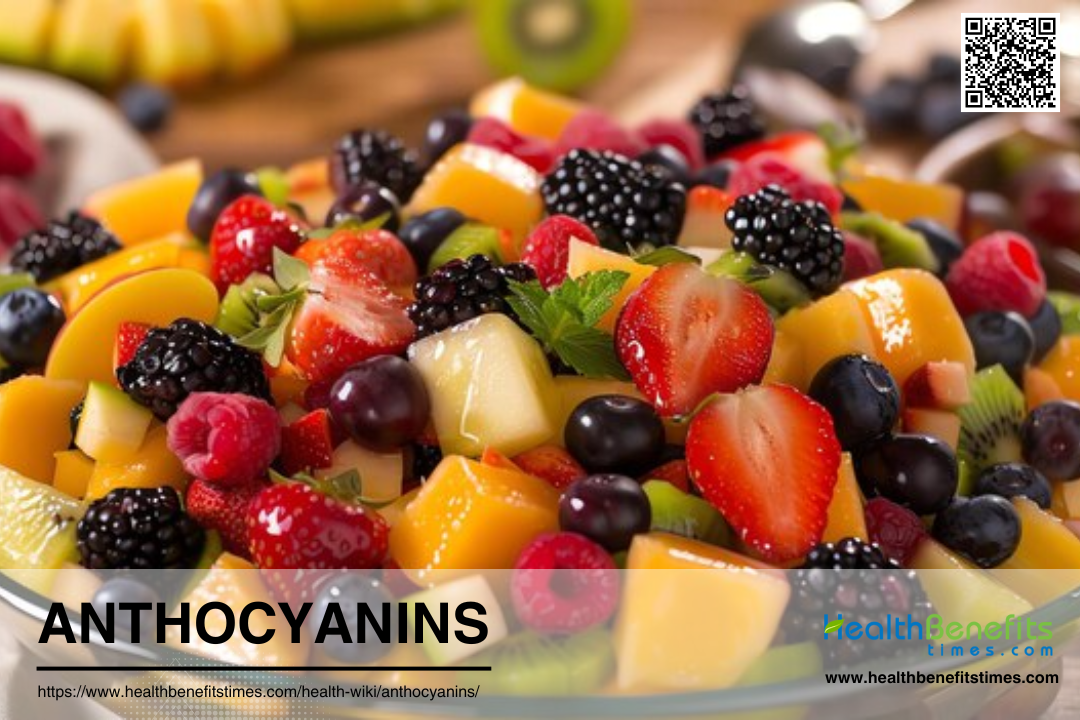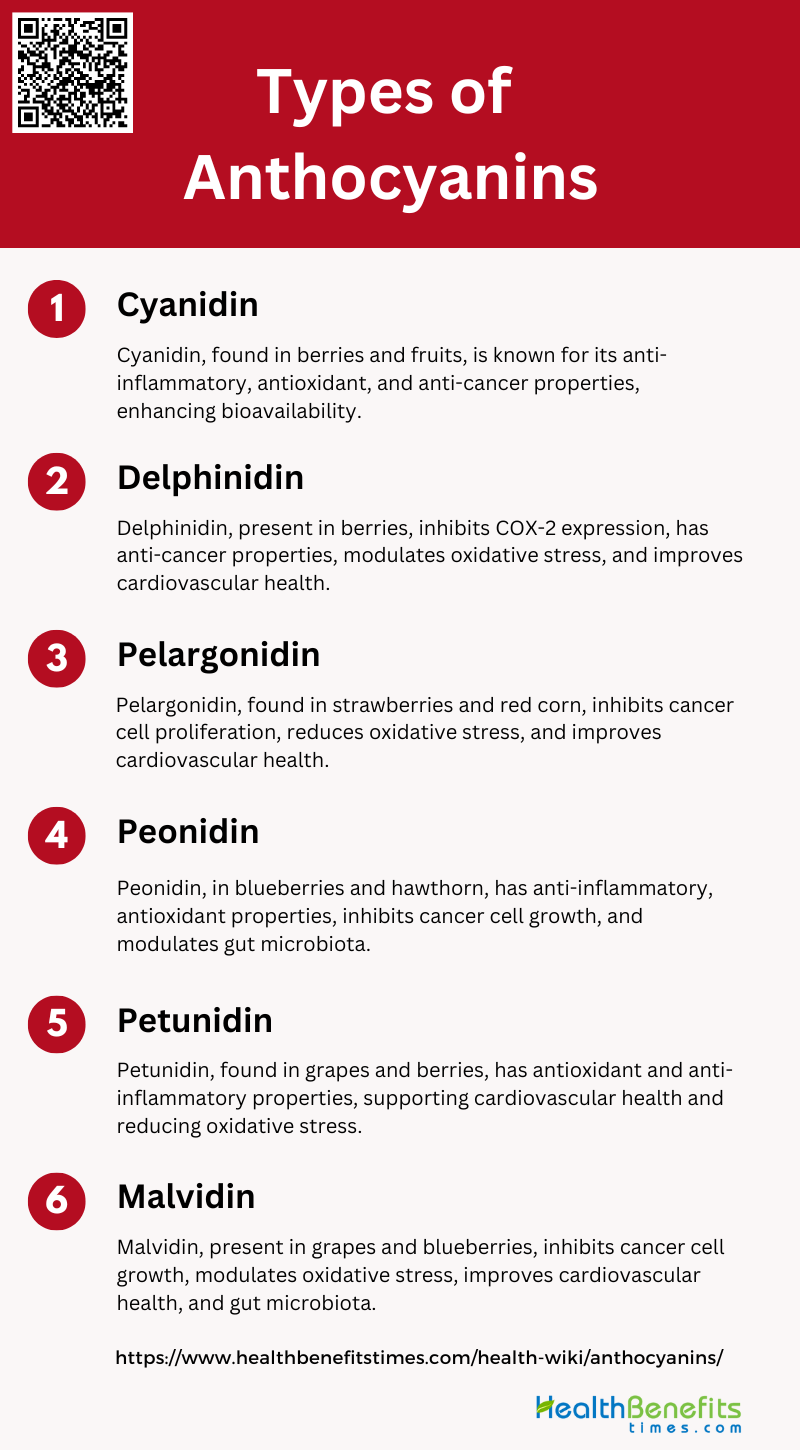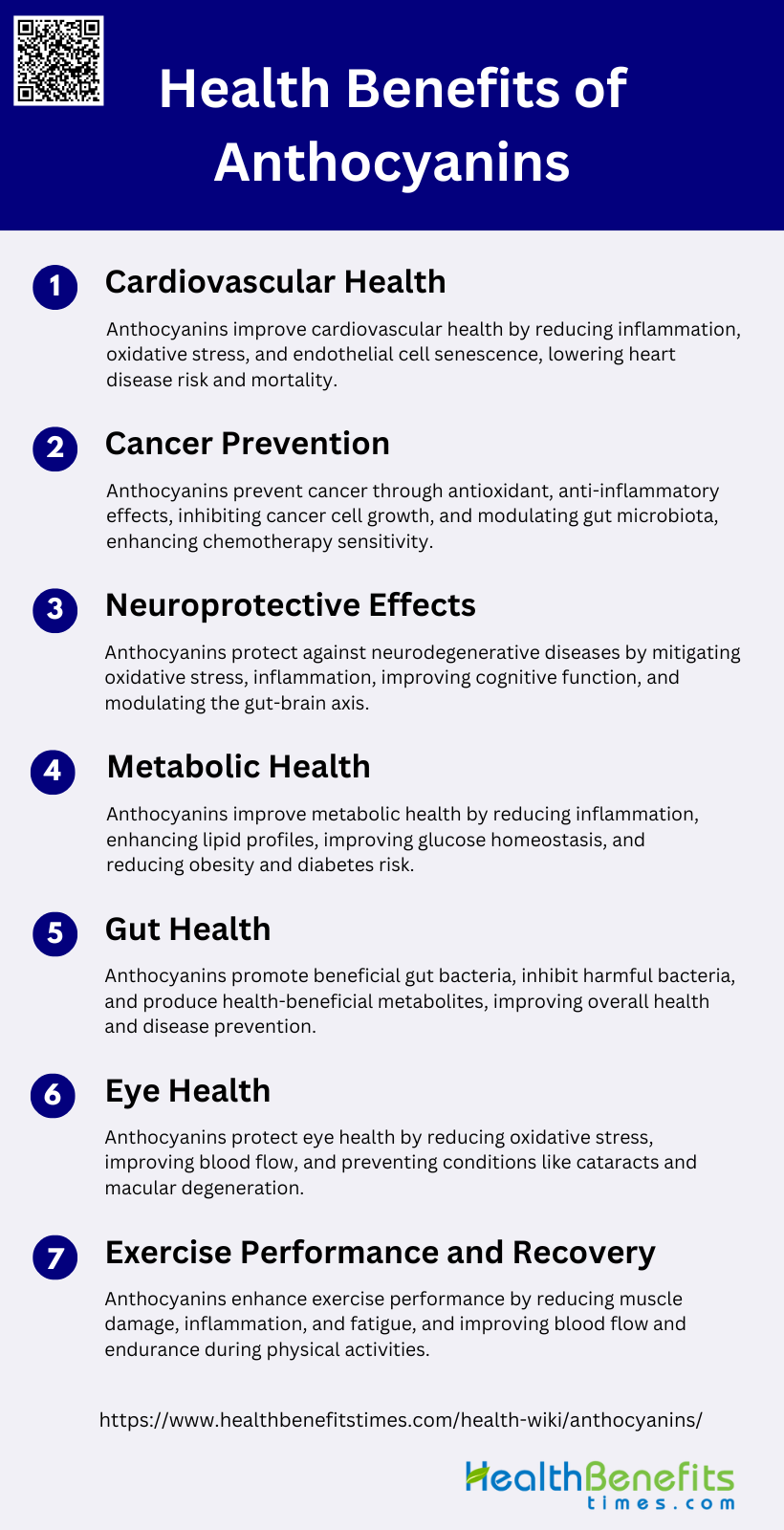Anthocyanins are a class of water-soluble pigments belonging to the phenolic group, responsible for the red, purple, and blue colors in many fruits and vegetables, such as berries, grapes, and red cabbage. These pigments are glycosylated forms of anthocyanidins and play significant roles in plant life, including seed dispersal and pollination. Beyond their aesthetic contributions, anthocyanins are renowned for their potent antioxidant, anti-inflammatory, and antimicrobial properties, which contribute to various health benefits, such as improved cardiovascular and neurological health, and protection against non-communicable diseases like diabetes and cancer. Despite their health benefits, anthocyanins are sensitive to environmental factors such as pH, light, and temperature, which can affect their stability and efficacy.
Types of anthocyanins
Anthocyanins are a group of naturally occurring pigments found in various fruits, vegetables, and flowers, responsible for their vibrant red, purple, and blue colors. These compounds not only contribute to the aesthetic appeal of plants but also offer numerous health benefits due to their antioxidant properties. Below are some of the most common types of anthocyanins:
1. Cyanidin
Cyanidin is one of the most prevalent anthocyanidins found in various fruits and vegetables. It is known for its deep red to purple coloration and is commonly present in berries such as blackberries, raspberries, and blueberries, as well as in other fruits like apples and plums. Cyanidin has been extensively studied for its potential health benefits, including its anti-inflammatory and antioxidant properties. It has been shown to inhibit the growth of human cancer cells and to modulate gut microbiota, which may contribute to its health-promoting effects. Additionally, cyanidin glycosides are metabolically converted to other beneficial compounds, further enhancing its bioavailability and efficacy.
2. Delphinidin
Delphinidin is another significant anthocyanidin, characterized by its blue to purple hue. It is predominantly found in fruits such as blueberries, black currants, and bilberries. Delphinidin has been identified as a potent inhibitor of cyclooxygenase-2 (COX-2) expression, which plays a crucial role in inflammatory processes. This anthocyanidin also exhibits strong anti-cancer properties, particularly against breast cancer cells, by inhibiting the epidermal growth-factor receptor (EGFR) and downstream signaling pathways. The health benefits of delphinidin are further supported by its ability to modulate oxidative stress and improve cardiovascular health.
3. Pelargonidin
Pelargonidin is known for its bright red to orange coloration and is commonly found in strawberries, raspberries, and red corn. This anthocyanidin has been shown to inhibit the proliferation of various human cancer cell lines, including stomach, colon, and breast cancer cells. Pelargonidin glycosides are metabolized into phenolic acids, which contribute to its anti-inflammatory and antioxidant effects. Additionally, pelargonidin-rich fruits have been associated with improved cardiovascular health and reduced oxidative stress, making it a valuable component of a healthy diet.
4. Peonidin
Peonidin is a methylated derivative of cyanidin, contributing to its red to purple coloration. It is found in fruits such as blueberries, black currants, and hawthorn. Peonidin glycosides are known for their anti-inflammatory and antioxidant properties, which are believed to be due to their stable phenolic acid metabolites. This anthocyanidin has also been shown to inhibit the growth of human cancer cells, particularly in breast cancer. The health benefits of peonidin are further supported by its ability to modulate gut microbiota and improve cardiovascular health.
5. Petunidin
Petunidin is characterized by its dark purple to blue coloration and is found in fruits such as grapes and berries. This anthocyanidin has been less studied compared to others, but it is known to possess antioxidant and anti-inflammatory properties. Petunidin glycosides are metabolized into smaller phenolic acids, which contribute to its health benefits. Although more research is needed, petunidin-rich fruits are believed to support cardiovascular health and reduce oxidative stress.
6. Malvidin
Malvidin is known for its deep purple to blue coloration and is predominantly found in grapes and blueberries. This anthocyanidin has been shown to inhibit the growth of various human cancer cell lines, including stomach, colon, and lung cancer cells. Malvidin glycosides are metabolized into unstable phenolic acids, which may contribute to its anti-inflammatory and antioxidant effects. The health benefits of malvidin are further supported by its ability to modulate oxidative stress and improve cardiovascular health. Additionally, malvidin-rich fruits are often associated with improved gut microbiota composition, further enhancing their health-promoting properties.
Sources of Anthocyanins
Anthocyanins are naturally occurring pigments responsible for the red, purple, and blue colors in many fruits and vegetables. These compounds are not only important for plant coloration but also offer various health benefits due to their antioxidant properties. Below is a list of common sources of anthocyanins:
1. Fruits
Anthocyanins are abundant in a variety of fruits, particularly those with red, blue, and purple hues. Berries such as blueberries, blackberries, and raspberries are especially rich in these pigments, contributing significantly to their vibrant colors and health benefits. Grapes, apples, and plums also contain substantial amounts of anthocyanins, which are known for their antioxidant properties and potential to reduce the risk of chronic diseases such as cardiovascular and neurodegenerative disorders. The high anthocyanin content in these fruits not only enhances their nutritional value but also makes them valuable in the prevention of diseases associated with oxidative stress.
2. Vegetables
Red cabbage, red radishes, and purple carrots are notable examples, with red radishes containing up to 34 different anthocyanins. These pigments are often highly conjugated with sugars and acylated groups, making their structures complex. Vegetables like red cabbage and red radish are rich in these compounds, which contribute to their vivid colors and potential health benefits, including anti-inflammatory and antioxidant effects. The presence of anthocyanins in these vegetables adds to their nutritional profile and supports their role in a healthy diet.
3. Other Sources
Beyond fruits and vegetables, anthocyanins are found in other sources such as grains, nuts, and certain beverages. Sorghum, a type of grain, contains unique 3-deoxyanthocyanidins and their derivatives. Pistachio nuts also have been identified to contain anthocyanins, although in smaller quantities compared to other sources. Additionally, fruit-derived beverages like red wine and certain teas are rich in these pigments, contributing to their health-promoting properties. The diverse sources of anthocyanins highlight their widespread presence in the diet and their potential benefits in promoting cardiovascular health and reducing the risk of chronic diseases.
Health Benefits of Anthocyanins
Anthocyanins are known for their numerous health benefits. These powerful antioxidants can help reduce inflammation, improve heart health, and support cognitive function. Below is a list of the key health benefits of anthocyanins:
1. Cardiovascular Health
Anthocyanins have been extensively studied for their cardiovascular benefits. Epidemiological data suggest that higher anthocyanin intake is associated with a reduced risk of myocardial infarction and cardiovascular-disease-related mortality. Clinical studies have shown that anthocyanin-rich foods can improve markers of cardiovascular health, such as reducing inflammation and oxidative stress, and improving vascular function. The underlying mechanisms include the modulation of gene and protein expression, interactions with cell-signaling pathways, and effects on miRNAs. Additionally, anthocyanins may help prevent endothelial cell senescence, a key factor in cardiovascular diseases.
2. Cancer Prevention
Anthocyanins exhibit a range of pharmacological effects that contribute to cancer prevention. These include antioxidant, anti-inflammatory, and anti-mutagenic properties, as well as the ability to induce cell cycle arrest and apoptosis in cancer cells. They also inhibit cancer cell proliferation, invasion, and metastasis, and can enhance the sensitivity of cancer cells to chemotherapy. The modulation of gut microbiota by anthocyanins may also play a role in cancer prevention, as a healthy gut microbiome is linked to reduced cancer risk. These multifaceted actions make anthocyanins a promising natural agent for cancer prevention.
3. Neuroprotective Effects
Anthocyanins have shown potential in protecting against neurodegenerative diseases. Their antioxidant and anti-inflammatory properties help mitigate oxidative stress and inflammation, which are key factors in neurodegeneration. Studies suggest that anthocyanins can delay symptoms in neuropathological conditions and improve cognitive function. The modulation of gut microbiota by anthocyanins may also contribute to their neuroprotective effects, as the gut-brain axis plays a crucial role in brain health. These findings highlight the potential of anthocyanins as a natural therapeutic agent for neuroprotection.
4. Metabolic Health
Epidemiological studies suggest that anthocyanin intake is associated with a lower risk of type 2 diabetes and improved glucose homeostasis. Clinical trials have shown that anthocyanins can reduce markers of inflammation and oxidative stress, improve lipid profiles by decreasing low-density lipoprotein (LDL) and increasing high-density lipoprotein (HDL), and enhance vascular function. These effects collectively contribute to better cardiometabolic health and reduced risk of metabolic disorders.
5. Gut Health
They promote the growth of beneficial bacteria and inhibit harmful ones, thereby improving gut health. The metabolism of anthocyanins by gut microbiota produces metabolites that are absorbed and contribute to their bioavailability and health benefits. This interaction between anthocyanins and gut microbiota can help prevent and treat various diseases, including cardiovascular diseases, cancer, and neurodegenerative disorders. Thus, anthocyanins are crucial for maintaining a healthy gut microbiome.
6. Eye Health
Their antioxidant properties help reduce oxidative stress in ocular tissues, which is a major factor in the development of eye conditions such as cataracts and age-related macular degeneration. Additionally, anthocyanins can improve blood flow to the eyes, enhancing nutrient delivery and waste removal. These effects contribute to better eye health and reduced risk of vision impairment, making anthocyanins a valuable component of a diet aimed at preserving eye function.
7. Exercise Performance and Recovery
Their antioxidative and anti-inflammatory properties help reduce muscle damage and inflammation, speeding up recovery after exercise. Anthocyanins also improve blood flow and vasodilation, which can enhance oxygen and nutrient delivery to muscles during exercise. While the effects on exercise performance vary depending on the source of anthocyanins, they generally contribute to reduced muscle fatigue and improved endurance. These benefits make anthocyanins a promising supplement for athletes and active individuals.
How to Incorporate Anthocyanins in Your Diet
Anthocyanins are powerful antioxidants found in many colorful fruits and vegetables, offering numerous health benefits. Incorporating these compounds into your diet can be both easy and delicious. Below are some effective ways to ensure you get enough anthocyanins in your daily meals:
1. Daily Recommendations
Incorporating anthocyanins into your daily diet can be achieved by consuming a variety of anthocyanin-rich foods. These include red fruits such as berries (blueberries, strawberries, raspberries), red grapes, and cherries, as well as red vegetables like red cabbage and beets. Studies suggest that regular consumption of these foods can provide significant health benefits, including anti-inflammatory and antioxidant effects, which may help mitigate conditions such as cardiovascular diseases, diabetes, and obesity. For optimal health benefits, it is recommended to consume a diverse range of these foods daily, aiming for at least one to two servings of anthocyanin-rich fruits and vegetables per day.
2. Supplements
For those who may find it challenging to consume sufficient anthocyanin-rich foods daily, supplements can be a convenient alternative. Research indicates that anthocyanin supplements can effectively improve lipid profiles, reduce oxidative stress, and enhance insulin sensitivity, particularly in individuals with metabolic disorders such as diabetes and dyslipidemia. Typical dosages in studies range from 160 mg to 320 mg per day, with higher doses showing more pronounced benefits in reducing inflammation and improving antioxidant capacity. However, it is essential to consult with a healthcare provider before starting any supplementation to ensure it is appropriate for your individual health needs and conditions.




